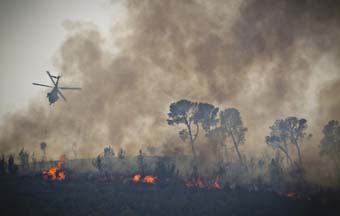
Last Friday, Universitat de València presented the preliminary report titled ‘Los grandes incendios del verano de 2012 en València’ (Valencian major fires in summer 2012). The Office of the Vice-Principal for Participation and Territorial Projection entrusted the full professor of physical geography Alejandro Pérez Cueva to write this report. It suggests rural reforestation of this land as an essential tool to avoid major forest fires, and other future solutions like biological firewalls that involve development of grasses.
The document was presented in Friday during the celebration of the 1st Foro de Incendios Forestales Universitat de València-Ayuntamientos, which is an encounter between the academic institution and the town councils to discuss on the forest fires which took place last summer. It was held at the Botanic Garden and its goal is to detect ‘the needs of the towns affected by the fires and gather the possible work of the Valencian local entities and the experts at Universitat de Valencia’, as the Vice-Principal stated.
The UV’s experts analyzed the major fires happened last summer –Benagéber, La Safor, Cortes, Andilla y Chulilla-, which destroyed a total of 63.520 hectares. ‘We are studying the basic elements of the disasters like the use of the ground, and the weather elements, but also the impacto of the fires’, Pérez Cueva affirmed. Only at the Andilla and Cortes towns, the fires affected valuable places like Sierra Calderona nature reserve, Martés, El Ave, and Malacara ranges, La Mola de Cortes and El Caroig, or the central stretch of the river Palancia; four micro flora reserves -Loma de coca (Real), Barranco de Pertecates (Tous), Umbría de la Peña Parda (Andilla), and Puntal de Navarrete (Altura)-; three fauna reserves in Alcublas: Balsa Silvestre, la Balsilla, and Balsa Pedriza.
This report also analyzes socio-economic and demographic matters: ‘we can see again that rural deforestation has favoured major fires, that is why we can say that reforestation is a key measure to prevent these forest fires’, adds the professor. The towns that have suffered the highest damage by fire are Dos Aguas (94,9%), Macastre (77,3%), Sacañet (67,45%), Alcublas (66,6%), Bugarra (66,2%), Teresa (59,38%), Catadau (49,2%), Llocnou de Sant Jeroni (42,11%), and Chulilla (38,36%).
‘Our work proves that conventional firewalls and natural barriers have not worked, so it is urgent to implement the biological firewalls, something which is already included in the Plan General de Ordenación Forestal de la Comunidad Valenciana, since they involve recovering traditional activities like pastures or farming activities’, Pérez Cueva argued. He also pointed out the importance of avoiding heavy machinery at areas just burned to avoid erosion.
Regarding the weather aspects, scientists analyzed the disasters and found three ways of behaving due to the wind. In the first of the fires, on the 1st July in Benagéber, flames were causes by breeze. In the second one, at La Safor area, there was a central focus and there was a variable flow of air, whereas the three last fires in Cortes, Andilla and Chulilla, on June 28 and 29 and September 23, were characterized by the classic and very persistent South-East wind.
The towns’ mayors claimed for a political will to implement effective measures of recovery. Manuel Civera, from the town council of Alcublas, stressed the economic value of the natural and environmental resources that are provided by these town in the interior of the province. He also added that despite all the national and European regulations deforestation has not been avoided, so there must be a real political effort to change the situation.
In his turn, the representative of the town council of Enguera, Santiago Arévalo, stated that ‘there will be no society without a cohesion between the coastal zones and inland areas.’ He also suggested new economic opportunities like energy solutions through biomass.
Last update: 22 de october de 2012 09:03.
News release



















